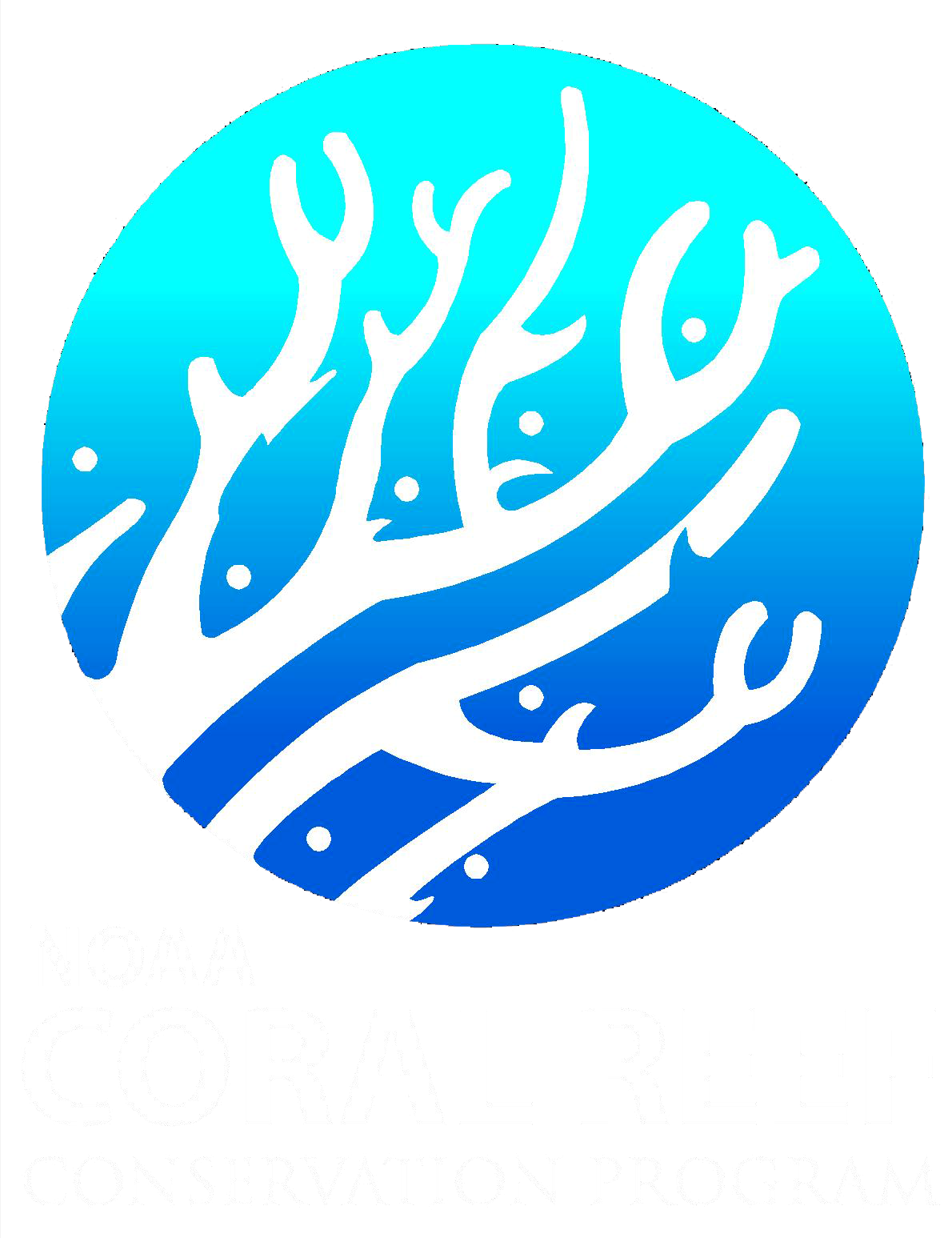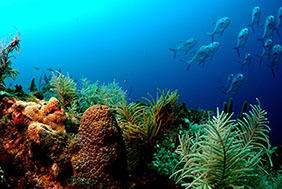Featured Archive - 2016 Publications
Below is a sampling of publications generated by NOAA's coral ecosystem activities in 2016. To access a complete list of NOAA coral ecosystem related publications, use the CoRIS Geoportal
(https://www.coris.noaa.gov/search/) search tool.
This report represents the culmination of three years of research by NOAA's National Centers for Coastal Ocean Science (NCCOS), Center for Coastal Monitoring and Assessment (CCMA) and local partners, in the St. Thomas East End Reserves (STEER) in the U.S. Virgin Islands (USVI). The purpose of this work was to provide local resource managers with a spatially comprehensive characterization of stressors including chemical contaminants, nutrients, and sedimentation along with their effects, and a biological survey of the entire STEER.
This document is a guide to the field identification of the Endangered Species Act-listed, threatened corals of the U.S.
Pacific. Species are presented in an order that groups similar corals together as much as possible, and
will present more common or widespread species at the start. In addition, other similar species are
presented to highlight the differences between taxa.
This report presents results from resilience and bleaching surveys conducted at two different depths along priority areas of South Kohala and North Kona in October of 2015. These surveys were conducted as a collaborative effort with the Hawaii Division of Aquatic Resources (DAR), The Nature Conservancy, SymbioSeas, NOAA Coral Reef Ecosystem Program, and community organizations.
The Shade Coffee Roundtable was created with the purpose to develop criteria for shade coffee certification for Puerto Rico; identify incentives for motivating coffee producers to continue to use historical agricultural practices that are sustainable and environmentally friendly; help create economic niches for the coffee produced in the shade that can be marketed separately and that results in greater profits for producers.
This report characterizes the pollutant loading and restoration potential for the 46.4-acre study area of the Honokōwai Beach Park (HBP), which was identified in the Wahikuli-Honokōwai Watershed Management Plan (WHWMP) as a location for a stormwater improvement project. This study evaluates the Honokowai drainage area in order to develop a more detailed water quality improvement plan, focusing on stormwater impacts (i.e., not wastewater, groundwater, etc.). This effort included additional field investigations, site topographic survey, mapping of the drainage network (e.g., catch basins, pipes, manholes), and the identification of numerous structural and non-structural stormwater restoration alternatives on public and private property.
This report describes the 2014 and 2015 research activities partially or fully funded by the Deep Sea Coral Research and Technology Program to meet NOAA's mandate to identify, study, and monitor deep-sea coral areas. The report is supplemented by details of these activities available at https://deepseacoraldata.noaa.gov/. The report also briefly describes progress during this period in Magnuson- Stevens Act-related management actions that contribute to protecting deep-sea coral areas.
This report outlines human dimensions information relevant to coral reef resources in South
Florida. The South Florida region is defined as the five counties adjacent to the Florida Coral
Reef Tract: Martin, Palm Beach, Broward, Miami-Dade, and Monroe Counties. The findings
here are derived from a combination of data gathered through household surveys conducted from
January to July of 2014, and additional secondary sources of socioeconomic information for the
region.
Many people involved in coral reef management know and use the Reef Manager's Guide to Coral Bleaching, the definitive manual for managers confronting one of the most dramatic impacts of climate change.
Building on the success of this publication, as part of an international consortium NOAA has just released the next installment in the Reef Manager's Guide family: A Reef Manager's Guide to Fostering Community Stewardship.
The Watershed Partnership Initiative (WPI) of the U.S. Coral Reef Task Force (USCRTF) selected three watersheds (Guanica, Puerto Rico; West Maui, Hawaii; and Faga’alu, American Samoa) as priority sites where local and federal agency resources are addressing land-based sources of pollution in watersheds located upstream of priority coral reef areas. Specific language to evaluate the programmatic, ecological and social/community engagement success of the partnerships was included in Resolution 28.1 which codified the WPI. Specifically, the resolution states that in support of the WPI, the USCRTF will, “Evaluate the success of this partnership to ensure that the resources contributed are being applied effectively and are having the intended impact on watershed management, water quality issues impacting coral reef ecosystems, and building an informed and engaged community.” In response, the Watershed Working Group of the USCRTF sought to develop tools for managers of the WPI sites to assist them with tracking progress of implementing their watershed management plans and documenting the efficacy of the management interventions taken to reduce land-based sources of pollution originating from the priority watersheds. Two new tools are now.
This technical memorandum presents the findings from the initial 2014 American Samoa NCRMP (National Coral Reef Monitoring Program) socioeconomic data collection. The report presents preliminary social indicators and provides examples of how they can be analyzed over the long term. It should be noted that this report presents information that, in many instances, is being collected for the first time. In all instances, the information represents baseline socioeconomic data for the NCRMP. Some of the variables presented in this report identify gaps in information, and we provide suggestions on how these can be addressed in the future. The main objective is to lay the groundwork for combining and comparing socioeconomic variables with a goal of developing meaningful indicators that can be used to examine trends in human dimensions of coral reef resources and better understand human influences on effective coral reef conservation.
The primary purpose of this document is to provide local and federal partners with baseline information, survey methods, and recommended actions to support continued monitoring efforts to evaluate the effectiveness of management actions taken at the Samoa Maritime quarry in Faga'alu, American Samoa to reduce land-based sources of pollution inputs, specifically excess sedimentation, to the coral reefs in Faga'alu Bay. This document summarizes work completed between 2012 and 2014 to gather baseline data and information before management interventions such as drainage systems, alternative ground cover, and retention ponds were installed at the quarry. To quantify effectiveness
of these interventions, additional long-term monitoring of sediment loads in Faga'alu Stream and coral community structure will be needed for comparison with the baselines presented here.
This guide is meant to serve as a quick reference for all those working in law enforcement, conservation, and management of marine resources in Puerto Rico and the U.S. Virgin Islands. It provides general descriptions of species that are either managed due to their importance in our local fisheries, or protected under the Federal Endangered Species Act of 1973.
This study characterizes the community of shore-based, non-commercial fishers on the island of St. Croix, USVI in terms of their fishing patterns over space and time and to the extent possible, their demographic and socioeconomic characteristics. The results and lessons learned from this study can inform future survey efforts of non-commercial fishers in the USVI.


